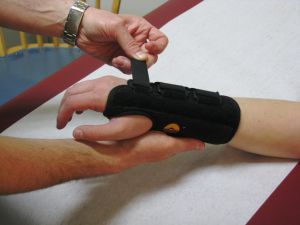 November 10, 2011 – It starts as a day like any other. Suddenly, you catch a toe on the curb, slip on wet grass, or discover that patch of ice lurking beneath the snow and you’re airborne with your arms instinctively extended to try to catch yourself. A hard landing on your hands is accompanied by sharp pain in the wrist and you know something is seriously wrong as your wrist quickly swells and becomes black and blue. You have sustained a distal radius fracture, the most common form of a broken wrist.
November 10, 2011 – It starts as a day like any other. Suddenly, you catch a toe on the curb, slip on wet grass, or discover that patch of ice lurking beneath the snow and you’re airborne with your arms instinctively extended to try to catch yourself. A hard landing on your hands is accompanied by sharp pain in the wrist and you know something is seriously wrong as your wrist quickly swells and becomes black and blue. You have sustained a distal radius fracture, the most common form of a broken wrist.
In assessing distal radius fractures we are concerned about a number of parameters. The first important question surrounds the integrity of the skin and soft tissue around the fractured bone. A fracture associated with a wound, a so-called open or compound fracture, is a surgical emergency and must be treated operatively within twelve hours of occurrence to minimize the risk of infection. Closed fractures, those in which the skin remains intact, are further categorized as intra-articular, affecting the joint surface itself, or extra-articular, lying entirely outside the joint.
Treatment options in adults include closed reduction and casting, wire fixation in conjunction with casting, external fixation, and rigid internal fixation with a plate and screws. Until the last decade, the majority of distal radius fractures in adults were treated with either closed reduction and casting or external fixation. With both of these methods, the wrist is immobilized for 6-8 weeks. This period of immobility creates significant stiffness in the wrist, and often in the fingers as well. Patients with displaced fractures treated with these methods frequently required months of Hand Therapy to regain even less than normal motion. Suboptimal function of the wrist and hand was the result.
About ten years ago, a Miami hand surgeon, and his colleagues developed a new plate designed to rigidly stabilize distal radius fractures while minimizing joint immobility. Whereas the wrist was immobilized for 6 to 8 weeks with the other methods of treatment, fractures stabilized with a volar plate can now be mobilized starting at 2 weeks. This has made a tremendous difference in how quickly and how fully patients regain motion at the wrist and fingers and has minimized the impact of distal radius fractures on long-term function. Our goal is not just to get the fracture to heal but to get people back to normal.
Once the fracture has been secured, rehabiliation can begin. A skilled hand therapist joins the patient and the surgeon as the third critical member of the wrist fracture recovery team. The initiation of therapy early in the healing process allows patients to take full advantage of the benefits this cutting edge technology offers. Starting with simple motion exercises two weeks following surgery, the wrist is mobilized and strengthened through a gradual, progressive program. The time to maximal recovery is generally half of that seen with earlier surgical methods, and the ultimate functional recovery is much closer to normal.
If you have injured your wrist, early evaluation by an Orthopaedic Hand Surgeon will help you choose optimal treatment. Getting the best care available can make the difference between ‘better’ and normal.



